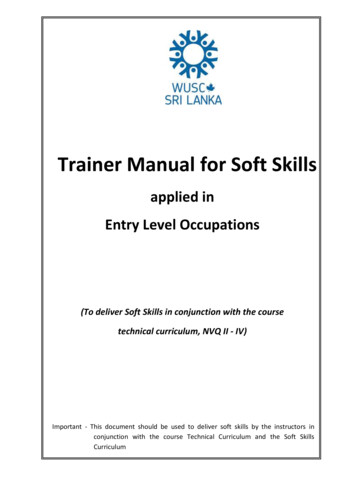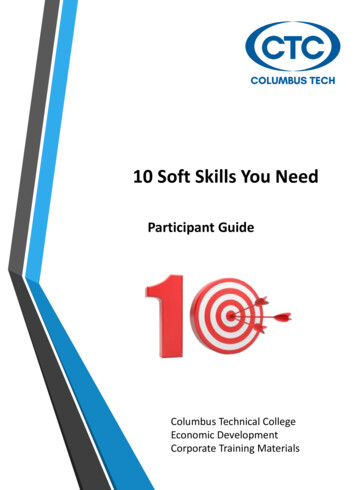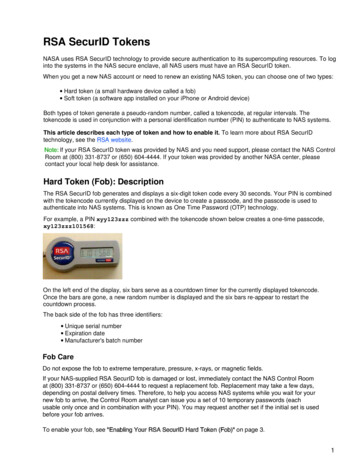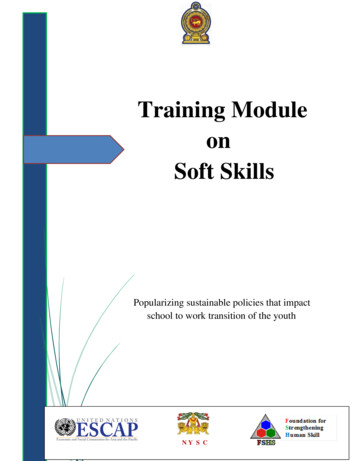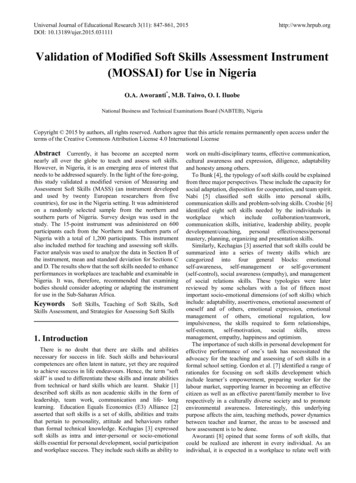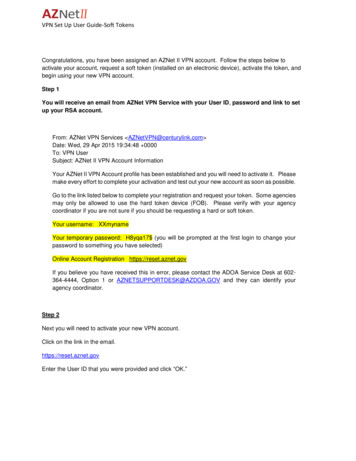
Transcription
System Thinking: Approaches and MethodologiesAn Overview of the Soft Systems MethodologyStuart BurgeThe Soft Systems Methodology (SSM) was born out of research conducted at Lancaster University toapply Systems Engineering approaches to solve “management/business problems”. In other wordsthey attempted to apply a Hard Systems approach to fix business problems. What they discoveredwas the approach often stumbled at the first step of problem definition. This happens quite simplybecause the different stakeholders have divergent views on what constitutes the system, thepurpose of the system and therefore the problem. Two key players in the development of the SSMare Peter Checkland [1999] and Brian Wilson [2001] who through “action research” were able to puttogether a practical and pragmatic approach to the identification and solution of “soft” ill-definedproblems. This methodology was more than just a process; Checkland and Wilson also developed aset of tools to help users carry out the steps. These include: Rich PictureConceptual ModelCATWOEFormal Systems ModelMore on these later because, at this point, I would like to focus on the approach. Figure 1 presents aview of the SSM. Since its origin back in 1970’s and 80’s it has changed as various workers haveadded their bit. Figure 1 shows a 7-step process approach to SSM. I have chosen this view, that whileit is an early representation, it does allow several key and important aspects of SSM to be madeclear.Figure 1: The 7 Step Soft Systems Methodology Burge Hughes Walsh 2015page1
System Thinking: Approaches and MethodologiesBefore launching into detail about the 7-steps it is worthwhile explaining the overall philosophybehind SSM. It was born of the recognition that the real world is complex and messy primarilybecause we, human beings, inhabit it. Each of us will have a different perception of the samesituation. That perception will be based upon concepts and beliefs we hold in our head – a mentalmodel(s) that we use to make judgments about reality. A simple example of this comes from BrianWilson [2001] one of the originators of SSM. He asks us to imagine two people watching a TVprogramme. Both have watched exactly the same pictures and heard exactly the same sounds yetthey reach completely different conclusions about whether it was a good or poor programme. Theyexpress their conclusions and then have an argument as to who is right! Actually, both are rightbecause each has used their own mental model that comprises concepts of what is good or not.If these concepts that form the mental models could be explicit rather than implicit, they could beused to compare against what was observed allowing each observer to defend their judgment. Theymay well disagree with the respective merits of their models, but the argument can now be carriedout on a more rational and defendable basis. It is the two words “rational” and “defendable” thatare important and form the basis of the SSM.In simple terms SSM takes the messy arguments of the real world caused by people having differentperceptions and creates defendable and rational models for comparison with what is happening inthe real world to help made judgments or recommendations as to the response to the issue orproblem. These rational and defendable models are called Conceptual Models are a based upon theuse of defensible logic. I would like to emphasise here is that the Conceptual Models are not modelsof the real world that we experience but logical models of what it could be like. SSM isn’t reallyproblem solving in the sense of analyzing the real world to find the root causes of issues. Centralthough to the building of the models is the use defensible logic that is deduced from a statement ofpurpose captured in a Root Definition of a relevant system. It is very important to note that theseConceptual Models are models of what logically needs to be done to achieve the purpose expressedin the Root Definition. Conceptual Models are a model of what “good” looks like that can becompared to reality in order to identify where change could be made. Unfortunately, the languageof SSM is not one of every day use.Returning now to figure 1, we can see that the lower have of the diagram is concerned with thisabstract systems thinking where step 3 is concerned with formulating the Root Definitions and step4 is developing the Conceptual Models of what needs to be done. In formulating the SSM Checklandet al where interested in systems that involve humans performing tasks and activities as opposed tothe classic equipment or machine focused Systems Engineering world that they came. To reinforcethis they speak about the Conceptual Models as Human Activity System. The upper half of figure 1 isconcerned with the real world, starting on the left hand side with attempting to establish what tothinks about. The right-hand side is concerned with what we are usefully going to be based upon theknowledge gain by comparing the logical Conceptual Models against the reality experienced.Let’s go through these 7 steps in a bit more detail. Burge Hughes Walsh 2015page2
System Thinking: Approaches and MethodologiesStep 1 Enter situation considered problematic: This step is concerned with the real world and thegathering of information and views about situations that are considered to be problematic andtherefore there is some scope for improvement. Typically, once it has been agreed that some changeor review is needed, this step also involves some basic research into the situation to gatherinformation on the key stakeholders and current performance and issues.Step 2 Express the problem situation: Recognising that the real world is messy, the second step inconcerned with capturing the multiple views of the situation. To accomplish this Checkland et aldeveloped the notion of a Rich Picture to capture the various perceptions. They understood thatcomplex situations could not be adequately captured by words alone, diagrams and pictures are farmore effective and can pack a higher density of information per cm2. The idea behind theconstruction of a Rich Picture of a particular situation is that it: Allows differences of interpretation to be identifiedPermits agreement to be made on the interpretation to be takenIs a source of inspiration as to what relevant systems could be modeled through theassimilation of relationships, issues etc. It helps identify themes to take into the systemsworld.Because every situation is different and it is necessary to capture this potential variety, there are noformal Rich Picture modeling symbols. However, over the years of use, a number have becomeaccepted as standard. Figure 2 shows a Rich Picture drawn by myself together with work colleagues.It was drawn as part of a marketing meeting to discuss how to win new business and it sums up ourcurrent situation.Figure 2: Win More Business Rich Picture. Burge Hughes Walsh 2015page3
System Thinking: Approaches and MethodologiesMy training and consultancy company BHW needs to win more business if it is to meet its strategicgoal of increasing size. What the picture captures are many subtleties that could not be achieved bywords alone. For example, the box labeled “marketing” contains lots of randomly placed boxescontaining “?”. This was drawn to say we don’t have an effective marketing system. Around this boxare some of the approaches to marketing we have tried, two of which have associated performanceresults. We have tried advertising (at great expense) but it yielded no business. Equally our websiteis now a major contributor to new business. The box labeled “winning” shows an orderly process, weare quite good at this achieving a success rate of over 80%; we know what to do and how to do it.The bottom right hand corner of the picture shows our existing customers (some big some small interms of revenue stream) aligned to our “product” portfolio (typically training courses). Here youcan see that an existing customer has been crossed out – a re-structuring has caused a shift intraining provision to an internally based system.What does this picture tell me? Primarily it helps me identify the Relevant Systems that I can takeinto the systems world. These are: Marketing systemNew product systemStep 3 Formulate Root Definitions of relevant systems of purposeful behaviour: This is a criticalstep in the SSM. The Root Definition is a statement of purpose that captures the essence of theparticular situation of the relevant system. At the heart of the Root Definition is the transformationthat is performed by the relevant system. This is captured by the main verb in the Root Definition.Let’s have a look at one for the “marketing system” identified above:Root Definition for the BHW Marketing SystemA company owned system to market the products and services of the companyto existing and future clients by the most appropriate cost-effective means.The Root Definition is important since it is this that is used to logically deduce what the company willhave to do in order meet the definition. This is captured as a Conceptual Model. To help ensure thata draft Root Definition is acceptable Checkland and Smyth (1976) developed the mnemonic CATWOEwhere:[C]The Customer: The individual(s) who receive the output from the transformation (inrecent times it has been recognised that the out of the transformation may be‘’negative” for some customers and “positive” others. This has led to a refinement ofCATWOE to BATWOVE where the C is broken into Beneficiaries and Victims![A]The Actors: Those individuals who would DO the activities of the transformation ifthe system were made real Burge Hughes Walsh 2015page4
System Thinking: Approaches and Methodologies[T]The Transformation: The purposeful activity expressed as a transformation of inputto output[W]Weltanschauung: It's a German word that literally means “world view”. It is thebelief that makes sense of the root definition[O]Owner: the wider system decision maker who is concerned with the performance ofthe system[E]Environmental Constraints: the key constrains outside the system boundary that aresignificant to the systemLet’s return to the Root Definition drafted for the marketing system and see how CATWOE fits[C][A][T][W][O][E]Existing and future clientsThe companyMarket the products and services of the companyProviding the most appropriate marketing to a particular client will promotecompany products and servicesThe companyAppropriate meansIf you experience difficultly in applying CATWOE to a draft Root Definition, then it needs re-drafting.Personally, I tend to have a go at the Root Definition and then use CATWOE as a test of quality.Some people recommend using it to help construct the draft. What is important is getting thetransformation correct, particularly the inputs and outputs. Here Checkland, Wilson and the otherSSM originators are quite strong in their understanding of what the transformation should be like.They argue that the concept is frequently misunderstood with many inadequate representations ofsystem inputs and outputs. Figure 3 pictorially shows the transformation concept:Figure 3: The Transformation ProcessThe usual error is to confuse the system input (that entity which gets changed into the output) withthe resources needed to bring about the transformation. For example, for the marketing system arelevant transformation would be:Un-marketed Products and services - Marketed Products and ServicesWhereas the following are wrong! Burge Hughes Walsh 2015page5
System Thinking: Approaches and MethodologiesPublicity material - more businessSeminars - more enquiriesCheckland defined some simple (but often forgotten) rule when defining transformations: T transforms I into OI must be present in O but in a changed stateAn abstract I must yield and abstract OA concrete I must yield a concrete OHence from these I hope you see why my marketing transformation is correct, but the other two arenot. Getting a correct representation of T is important because it makes the model building relativelystraightforward.Step 4: Build Conceptual Model of Human Activity SystemsThe best way to introduce this stage is to show an output – a Conceptual Model. Figure 5 shows anexample draft Conceptual Model for the BHW Marketing System.Figure 5: Draft Conceptual Model of the BHW Marketing System. Burge Hughes Walsh 2015page6
System Thinking: Approaches and MethodologiesThe Conceptual Model shown in figure 5 is not quite complete yet but is typical of the starting pointwhen constructing the model. The symbols used are based upon those used by Brian Wilson [2001]with the activities that are necessary to undertake the transformation defined in the Root Definitionin the “squarish” boxes. Checkland suggested aiming for 7 2 activities that are at the “same scale”.The 7 2 comes, of course, from the work of George Miler [1970]. The other key point to note aboutfigure 5 is that each activity square contains a description of the activity that starts with a verb – andnot any old verb but an imperative or command verb.The arrows show the logical dependences. I have also numbered the activities. This is not standardpractice but one I adopt for easy reference and also for traceability if the activities are furtherdecomposed. Returning to the arrows, you will see an arrow going from activity 1 to activity 2. Thismeans that activity 2 is dependent upon activity 1, not that activity 1 must be complete beforeactivity 2 can start, but certain sub-activities must be completed. Typically, this is because activity 2needs some of the outputs of activity 1.Again, not standard practice but something I find very useful when constructing Conceptual Modelsis to make simple notes (on sticky notes) about the rationale behind a particular activity in themodel. Wilson (2001) coined the term “defensible logic” when constructing Conceptual Models andit is important to remember we are NOT modelling the real-world system but those activities thatare necessary to deliver the Transformation in the Root Definition. I’m not pessimistic, but I like tohave my arguments ready for the occasional cynic you find in the real world. Figure 6 shows thesticky notes I wrote when developing figure 5.Figure 6: The Rationale for the Activities in the Draft Conceptual Model Burge Hughes Walsh 2015page7
System Thinking: Approaches and MethodologiesWhen I introduced the Conceptual Model shown in figure 5, I said it was not complete. Soft SystemsMethodology, Root Definitions, CATWOE and Conceptual Models were specifically developed forHuman Activity Systems (HAS). These are systems that achieve their purpose through humanactivity as opposed to software intensive systems or hardware (product) intensive systems. It is thefact that HAS contains humans that makes figure 5 incomplete.As an engineer I used to design systems that the output was known and certain. For example, agearbox where one revolution on the input shaft will produce precisely X revolutions of the outputshaft. We could even model wear in a predictable way and take that into account, knowing exactlywhen to replace a component because it would fail in the next few cycles. These systems aredeterministic. Throw a few humans in to the equation and determinism goes out the window.Humans are neither “repeatable” nor “reproducible” in their actions. If I ask somebody to repeat anactivity the results or output will vary. I spend many nights each year in hotels, often the same hotelwhere I will be checked-in by the same member of staff, but every check-in experience is different.Reproducible is getting different people to perform an activity the same – not possible. Furthermore,we learn, we adapt, and we evolve and so our behaviour and performance will change over time. Itis this inherent variability in human performance that led Checkland et al to deem it necessary withHAS to introduce monitoring and control of the operational activities in figure 5. The operationalactivities are those activities that are logically necessary to perform the transformation stated in theRoot Definition Each activity in figure 5 needs to be monitored to determine whether it is being donewell and control action taken if it is not.There appears to be a “split in the ranks” at this point between Checkland and Wilson as to how tomodel this control action. Let’s start by looking at Checkland’s view. Checkland argued that theConceptual Model should be that of a system, an entity which can adapt and survive in a changingenvironment. It is because of this that it is necessary to add to the operational subsystem a monitorand control subsystem that examines the operations and take control to maintain or improve them.He said “any [human activity] system model is thus a combination of an operational subsystem and amonitoring and control subsystem” as shown in figure 7. I have added the “[human activity]” to thequotation because some systems do not have a monitoring and control subsystem and to infer thatall systems must is not correct. The gearbox I used and an example of a hardware-based system(depending on type) does not have to have a monitor and control sub-system. Having said that manymodern gearboxes include a significant amount of monitoring and control. I feel there is aninteresting aside here regarding system level. The gearbox in the transmission subsystem of amotorcar, may not have a monitor and control element, nor may the transmission subsystem. But isI go a level higher as the motorcar or system level, there will be a monitor and control elementprovide by the human driver who will monitor the vehicles speed, engine revolutions, engine soundto decide (take control action) when to change gear. Burge Hughes Walsh 2015page8
System Thinking: Approaches and MethodologiesFigure 7: The general structure of a model of a purposeful Human Activity SystemThe way in which Checkland approached “monitoring and control” was by thinking about failure andargued (Forbes and Checkland [1978]) that there are three potential answers which were expressedas the three E’sEffective: is the system doing the right thing - contributing to the higher-level goalsEfficacy: is the system providing the desired resultEfficient: is the system using the minimum of resourcesThe introduction of the three E’s led to the realisation that two levels of control are necessary. Thefirst monitoring and controlling the operational activities would address Efficiency and Efficacy. Thesecond level is monitoring and controlling the monitored and controlled operational activities.Checkland argues that the effectiveness of a system of interest can only be assessed by taking in toaccount the wider system, or systems, to which it is part. This two-level monitor and control view isshown in figure 8. Burge Hughes Walsh 2015page9
System Thinking: Approaches and MethodologiesFigure 8: The general structure of a model of a purposeful Human Activity System showing the higher-levelmonitoring and control necessary for assessing and managing effectiveness.It is this second level of monitoring and control that Wilson objected too. He argued that since theoperational activities are determined by defensible logic from the Root Definition they must becorrect, they must be effective. Therefore, only one level of control is actually necessary. Toreinforce his point, he also started to draw his Conceptual Models differently introducing some newsymbols. Firstly, he argued that every activity in the operational subsystem will need to bemonitored and therefore there should be an arrow from the various activities to the “MonitorOperational Activities” activity. All these arrows would add unnecessary detail and lead to confusion;hence Wilson introduced the block arrow to represent performance information collected fromevery operational activity as shown in figure 9a. Equally, the “Take Control Action” activity canproduce a control output to every operational activity. To represent this Wilson introduced thecrooked arrow shown in figure 9b.(a)(b)Figure 9: Wilson’s Additional Symbols for Conceptual Models Burge Hughes Walsh 2015page10
System Thinking: Approaches and MethodologiesUsing these symbols, Wilson would represent Figure 8 differently as shown in figure 10.Figure 10: The general structure of a model of a purposeful Human Activity System using Wilson’s NotationI can see both points of view and depending which side of bed I get out of will side with one or theother. Systems over time will adapt and evolve to their changing environment and therefore theremay well be a need to ensure that the “system” is still correct – effective. However, for any givenpurpose statement what has to be done to achieve that purpose is invariant. It will not change overtime.The key thing to remember is that that we are trying to piece together, with our Conceptual Model,a logical view of the activities necessary to achieve a system purpose.Step 5: Compare Models with the real worldStep 5 is where we return to the real world and compare the reality we experience with thatcaptured in the models. The purpose of the comparison is to initiate discussion from which changesto improve the situation can be identified. The approach uses the models to provide a means ofperceiving a different view of reality by testing assumptions that may exist but are ill founded. It isthe differences between what happened in reality and the logical model that raises the questionsthat will ultimately lead to change. Burge Hughes Walsh 2015page11
System Thinking: Approaches and MethodologiesThe way I undertake Step 5 is construct a table with three columns. The first contains the activities inthe Conceptual Model. The second contains what happens in reality and the third what can we do tobring reality closer to the logically defensible Conceptual Model. A table for my company’smarketing dilemma is shown in figure 11.Conceptual Model ActivitiesReal WorldWhat could we doIdentify potential/ currentcustomers & understandtheir needsPerformed on an ad hoc basis by thepartners. No real systematic approachto identifying potential customers andelicitation of needs1. Design develop andimplement a moresystematic approachReview currentproduct/service portfolioPortfolio developed on an asrequested basis. No overarchingstrategy for product or serviceofferings2. Establish a formal reviewprocess with in eachbusiness area and acrossthe company as a wholeCreate marketing materialof products and servicesCreated on an as required basis. Noconsistent format, approach ormessage.3. Agree a standard formatfor marketing material anddevelop materials for allcurrent products andservicesDevelop new products andservicesPerformed on an as required basis forprospective customers4. Establish business areaplanning for new productsand servicesDefine unique competitiveadvantage for CompanyEndless debates about what is uniqueabout the company. It clearly is uniqueas our client base comprises mainlylarge multi-national companies orgovernment organizations5. Seek advice and guidanceon how to define and agreeour unique competitiveadvantageAssess CompetitionNo systematic analysis performed6. Don’t bother – if ourproducts and services areokay clients will come OR7. Undertake a detailcompetition assessmentexerciseIdentify routes to marketfor each customer(strategy)To date a rather random approach8. Perhaps need guidance onwhat is possiblePerforming marketingactivity to strategyNot done – marketing passiveDo it!Monitor OperationalactivitiesEstablished quarterly marketingmeetings9. Make this element aformal item on the MeetingAgendaTake Control ActionNothing10. Use the Marketingmeeting actions to drive thecontrol actionFigure 11: Conceptual Model – real world Comparison TableStep 6: Define Changes that are both Desirable and FeasibleThe table shown in figure 11 contains a number of things we could do that would take the real-worldactuality closer to the Conceptual Model. In the ideal world all the recommendations would be Burge Hughes Walsh 2015page12
System Thinking: Approaches and Methodologiesimplemented. The company is however, a live organization with finite resources (in terms of peopleand money). Pragmatically we will have chosen the order and timescales for implementing (or not)the recommendations. While this sounds like an easy step, it is in fact fraught with difficultly. Peoplewill not always be motivated to implement change even if it is founded on the logic of theConceptual Model. Because SSM was developed for Human Activity Systems it is necessary torecognise that people involved in the potential change could hold conflicting views even if the logicof the Conceptual Model is undeniable. If change and culture clash – culture wins. This need forcultural feasibility is something which scientists and engineers sometimes find difficult. They tend tooveremphasize the importance of logic and fail to notice cultural aspects that determine whether ornot change will occur. This is one reason why it is important to think carefully about theWeltanschauung of each Root Definition.Returning to company’s marketing dilemma, our approach to this was to use a Change Managementtool called an Ease Benefit Matrix. This is shown in Figure 12 where the size of the circles indicatesthe amount or resources required to complete the task. The larger the circle the more resourcesdeemed necessary. The numbers relate back to the “what could we do” column in figure 11. So, forexample the 3-circle is saying we have an idea for change (Agree a standard format for marketingmaterial and develop materials for all current products and services) that has a high benefit, isrelatively easy to do but will require significant resources to complete.Figure 12: Ease Benefit MatrixLike all tools, the Ease Benefit Matrix should be used to promote, structure and organize thinkingand debate that will allow decisions for change to be made. Burge Hughes Walsh 2015page13
System Thinking: Approaches and MethodologiesStep 7 Take action to Improve the Problem Situation: Once we have identified the changes that areconsidered ‘desirable’ and ‘feasible’ effort is expended to implement these. This implementation willresult in new systems that will affect the bigger system leading to more opportunities and problems;and so, the process starts again.SummaryI find the SSM fascinating because of its approach. Rather than hunt for root causes to fix a problem,just use logic to define what “good” look like and move towards it. It is subtly different from other“problem” solving approaches and therefore can offer a refreshing alternative. I have to admit,however, it has taken me some time to get to grips with SSM primarily because the texts on thesubject as not easy reads.ReferencesCheckland P. Systems Thinking, Systems Practice, 1999, Wiley, ISBN 0-471-98606-2Wilson B. Soft Systems Methodology Conceptual Model Building and its Contribution, 2001, WileyISBN0-471-89489-3Miller G.A. “The Psychology of Communication” 1970, Pelican books, 140211411Forbes, P. and Checkland, P.B. (1987). ‘Monitoring and control in systems models’, InternalDiscussion Paper 3/87, Department of Systems, University of Lancaster Burge Hughes Walsh 2015page14
Rich Picture Conceptual Model CATWOE Formal Systems Model . More on these later because, at this point, I would like to focus on the approach. Figure 1 presents a view of the SSM. Since its origin back in 1970's and 80's it has changed as various workers have added their bit. Figure 1 shows a 7-step process approach to SSM.

